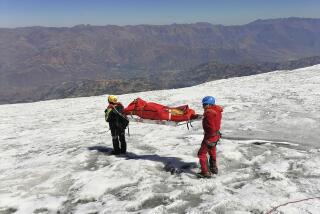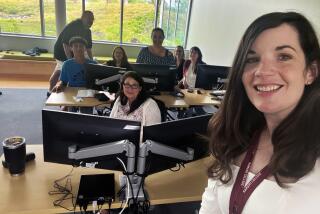DNA Test Could Solve Mystery of Missing WWII Pilot
ONTARIO — For weeks, Gladie DeFouw used stolen moments to write a letter to her brother, a pilot fighting in World War II, with news of the family.
A month later, the letter was returned--unopened.
Her brother, 2nd Lt. Harvey Bos, and two others were reported missing in action Jan. 6, 1945, after their C-46 cargo aircraft disappeared between China and India.
“We treated it like a nightmare,” DeFouw said in a recent interview at her Southern California home. “We didn’t have a memorial for him. We thought he would come back. There were lots of soldiers who were reported missing and ended up coming back.”
Fifty-five years later, Bos may be coming home. His family is trying to return what they believe to be his remains from an unmarked grave in the Philippines.
But first they have to get through the military bureaucracy.
Military documents uncovered by the family suggest the pilot’s remains, along with those of two crew members, appear to be buried in unmarked graves at the American Cemetery in Manila, a few hundred yards from where their names are etched in the Tablets of the Missing.
No Reply Yet From the Army
Sens. Dianne Feinstein, D-Calif., and Carl Levin, D-Mich., reviewed the documents and have petitioned the Department of the Army to exhume the remains and conduct DNA tests.
“We have been in contact with the Army and we are seeking assistance for the family,” said Feinstein spokesman Howard Gantman. “We are waiting to hear back.”
A telephone call to the Army’s Director of Mortuary Affairs and Casualty Support Division in Hawaii for comment was not returned.
As the family waits for an answer from the Army, they are honoring Bos and the other two men today. They have paid an Internet company to have flowers placed on the unmarked graves in Manila and pictures taken of the markers.
“The soldier buried at the Tomb of the Unknowns was laid to rest through DNA testing. Doesn’t my mother’s brother have the same right to be laid to rest in the country he gave his life for?” said DeFouw’s daughter, Judy Apodaca.
The family’s journey to find Bos began last year after DeFouw, 75, was diagnosed with cancer. She later went into remission.
“I asked my mom if there was anything I could do for her and she said, ‘I’d like to know what happened to my brother,”’ Apodaca said.
So Apodaca, aided by details from Bos’ widow, took to the Internet to see if she could find somebody who may have known Bos during the war or flown with him--anybody who might be able to shed light on his last days.
But with little knowledge of the crash or even Bos’ unit and squadron number, the search was in vain until she was advised by a friend to make a Freedom of Information Act request for his records.
Although most of Bos’ military files, like thousands of others, were destroyed in a 1972 fire, the Army found and forwarded to the family a copy of a casualty and case review report filed by the Army’s American Graves Registration Service on Jan. 9, 1948.
For the first time, DeFouw learned the details of Bos’ disappearance. He had been flying a cargo mission around the Himalayas, known to pilots as the “Hump,” from a base near Sookerating, India, to Chanyi, China, on Jan. 6, 1945, the report said.
Flying with the 23-year-old Bos, according to the report, were 2nd Lt. Ray C. Taylor and Pvt. Robert L. Crowder. Their ages and hometowns were not listed on the report.
“That was the first time I heard that he wasn’t alone, that there were others missing with him,” DeFouw said.
The report, signed by Maj. Edward Winterling, concluded the cargo plane, carrying gasoline, was either forced down in bad weather or crashed into the side of a mountain.
But it was the report’s details about the remains that most stunned the family.
The report says the remains of the three crewmen were believed to have been recovered “unidentified” from Lien San Po Mountain in western China and buried in China’s Kunming Cemetery as unknowns in November 1945. The bodies later were evacuated during the communist takeover to the Remains Depot in Shanghai, and then moved and reburied by 1947 in the Manila cemetery, the report said.
The records do not indicate who recovered the remains, why they were buried as unidentified or how they came to be in the cemetery.
The report recommended “further research be made on unknowns X-818 through X-820 (grave markers) to determine whether these remains are those of the crew members.”
“How could they have known this might be them and not told us?” DeFouw asked. “What about those other men’s families? Don’t they have a right to know, too?”
But when DeFouw and Apodaca requested information about the three unmarked graves, they said they were told the burial records no longer existed.
Then a chance conversation with the director of the National Archives in Washington, D.C., revealed the records did exist. Although the family hasn’t seen the records, they believe they have sufficient proof for the Army to test the remains.
That’s when Apodaca, 50, took the search public, giving interviews to The San Bernardino County Sun, and sending copies of the documents to lawmakers and military officials.
For years, DeFouw has waited for word about her brother. Once in a Chicago airport, she believed she saw him and tapped a man on the shoulder.
“From behind it looked just like him. When he turned around, I knew of course it wasn’t him. My family thought I was crazy,” she said. “But you have to understand, my mother died when I was young. Harv guided the family. He kept an eye out for me.”
If the remains are identified, the family plans to bury Bos next to his parents in the family plot in Standale, Mich.
“One of my dad’s last requests was for a headstone to be placed on one of these grave sites to be ready for when Harvey came home,” DeFouw said. “If he comes home, I’ll bury him there and tell him to rest in peace. He deserves that much.”
More to Read
Sign up for Essential California
The most important California stories and recommendations in your inbox every morning.
You may occasionally receive promotional content from the Los Angeles Times.









